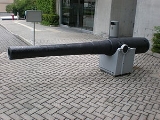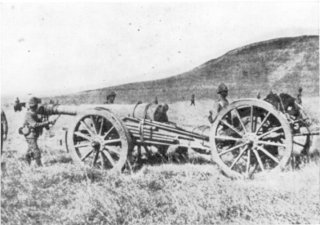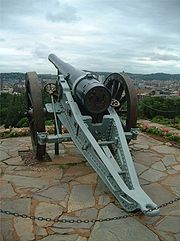
BL 5 inch gun Mk I - V
Encyclopedia
The BL 5 inch guns Mk I - Mk V were early British 5-inch breechloading naval guns after it switched from muzzle-loaders in the late 1870s. They were originally designed to use the old gunpowder propellants. The 5-inch calibre was soon discontinued in favour of QF 4.7-inch
.
 Guns equipped the following British warships :
Guns equipped the following British warships :
These guns also equipped several small gunboats of Colonial navies of Australia
in the 1880s in response to the perceived threat of Russian expansionism in the Pacific (The "Russian scares").
Second Boer War
 A number of guns mounted on carriages from obsolete RML 40-pounder guns accompanied the British siege train (heavy artillery) to South Africa. They were not required for the expected siege of Pretoria, which did not eventuate. Its usefulness in the field was limited by lack of a recoil control system, and the QF 4.7 inch gun
A number of guns mounted on carriages from obsolete RML 40-pounder guns accompanied the British siege train (heavy artillery) to South Africa. They were not required for the expected siege of Pretoria, which did not eventuate. Its usefulness in the field was limited by lack of a recoil control system, and the QF 4.7 inch gun
was the most commonly used British heavy gun in the war.

QF 4.7 inch Gun Mk I - IV
The QF 4.7 inch Gun Mks I, II, III, and IV were a family of United-Kingdom 120-mm naval and coast defence guns of 1888 and 1890s which served with the navies of various countries. They were also mounted on various wheeled carriages to provide the British Army with a long range gun...
.
Naval service

- Mariner-class gunvesselsMariner class gunvesselThe Mariner class was a class of 8-gun gunvessels built for the Royal Navy between 1883 and 1888.-Design:...
of 1883 - Satellite-class sloopsSatellite class sloopThe Satellite class was a class of 12-gun composite sloops built for the Royal Navy between 1883 and 1888, and reclassified as corvettes in 1884.-Design:...
of 1883s as re-gunned in the 1880ss laid down in 1885 - Calypso-class third class cruiser/corvettesCalypso class corvetteThe Calypso class comprised two steam corvettes of the Royal Navy. Built for distant cruising in the heyday of the British Empire, they served with the fleet until the early twentieth century, when they became training ships...
of 1883–84 - Iris-class cruisersIris class cruiserThe Iris class comprised two ships, and , which served with the Royal Navy. They were the Royal Navy's first all steel ships.They were designed as dispatch vessels by William White under the direction of Nathaniel Barnaby but were later re-created as Second Class Cruisers...
as re-gunned in 1888 - Beagle-class sloopsBeagle class sloopThe Beagle class was a two-ship class of 8-gun screw steel sloops built for the Royal Navy in 1889.-Design:Beagle and Basilisk were constructed of copper-sheathed steel to a design by William White, the Royal Navy Director of Naval Construction...
of 1889 - Bacchante-class corvettesBacchante class corvetteThe Bacchante class was a group of three iron screw corvettes in service with the Royal Navy from the late 1870s.-Design and construction:...
as re-gunned in the 1880s
These guns also equipped several small gunboats of Colonial navies of Australia
Colonial navies of Australia
Before Federation in 1901 five of the six separate colonies maintained their own naval forces for defence. The colonial navies were supported by the ships of the Royal Navy’s Australian Station which was established in 1859...
in the 1880s in response to the perceived threat of Russian expansionism in the Pacific (The "Russian scares").
Second Boer WarSecond Boer WarThe Second Boer War was fought from 11 October 1899 until 31 May 1902 between the British Empire and the Afrikaans-speaking Dutch settlers of two independent Boer republics, the South African Republic and the Orange Free State...
(1899 - 1902) field gun

QF 4.7 inch Gun Mk I - IV
The QF 4.7 inch Gun Mks I, II, III, and IV were a family of United-Kingdom 120-mm naval and coast defence guns of 1888 and 1890s which served with the navies of various countries. They were also mounted on various wheeled carriages to provide the British Army with a long range gun...
was the most commonly used British heavy gun in the war.
Coast defence gun
The gun was installed as a conventional coast defence gun in South Africa and Australia, and several in the United Kingdom. Its more common use ashore in the UK was as "moveable armaments" in forts : on 2-wheeled carriages similar to field carriages but intended only for moving short distances to position guns for defence of the fort. These used either obsolete 40-pounder RML carriages or special high-mounting carriages for firing over parapets with recoil controlled by a hydraulic buffer built into the platform to which the carriage was fastened. See diagram at Palmerston Forts Society.Surviving examples

- A gun on the deck of HMS GannetHMS Gannet (1878)HMS Gannet was a Royal Navy screw sloop launched on 31 August 1878. She became a training ship in the Thames in 1903, and was then lent as a training ship for boys in the Hamble from 1913...
, Chatham, UK. - 2 guns on 40-pounder RML field carriages, outside the Union BuildingsUnion BuildingsThe Union Buildings form the official seat of the South African government and also house the offices of the President of South Africa. The imposing buildings are located in Pretoria, atop Meintjieskop at the Northern end of Arcadia, close to historic Church Square and the Voortrekker Monument...
, Pretoria, South Africa - Outside the entrance to the Hong Kong Museum of Coastal DefenceHong Kong Museum of Coastal DefenceThe Hong Kong Museum of Coastal Defence is a museum in Hong Kong, located in a former coastal defence fort overlooking the Lei Yue Mun channel, near Shau Kei Wan on Hong Kong Island. The fort was built by the British in 1887, intended to defend the eastern approaches to Victoria Harbour.The total...
- No. 479 on Vavasseur mount at Queens Park, Maryborough, Queensland, Australia
- A gun on Vavasseur mount at The Esplanade, Cairns, Queensland, Australia

